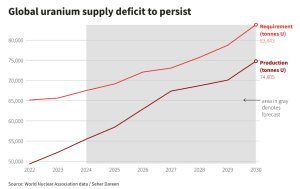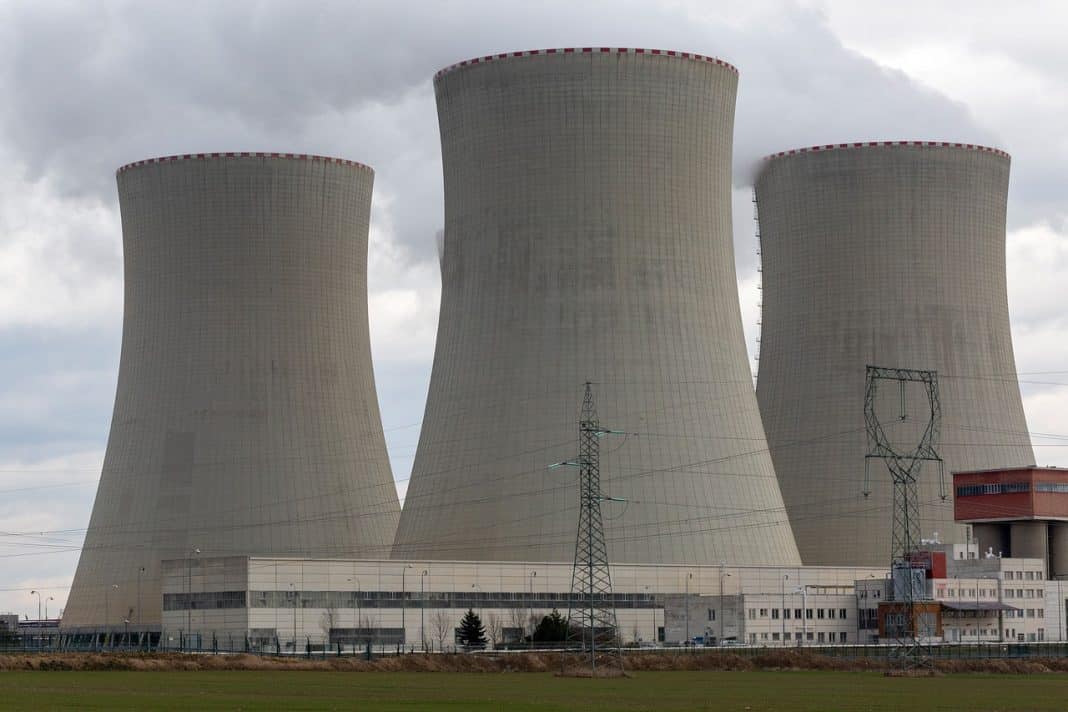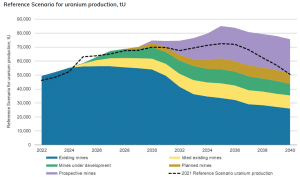Long-term uranium contract prices have reached over 16-year highs due to supply uncertainty and increased demand from utilities expanding capacity for AI data centers. Current term prices are around $79 per pound, the highest since 2008, with expectations of further increases.
Cameco, a leading uranium miner, reported securing contract prices with ceilings of $125-130 per pound and floors of $70-75 per pound, the best prices seen in over a decade. Spot uranium prices, which hit a 14-year high in February 2024, are now around $82 per pound.
Uranium Market is Heating Up
Uranium is the primary fuel for nuclear energy. The International Energy Agency predicts that global nuclear generation could double by 2050, calling for a corresponding increase in supply.
However, Plenisfer Investments estimates that prices must exceed the marginal cost of production, currently $90-$100 per pound, by at least 30% to incentivize new projects. This projection suggests a continued market deficit over the next decade.

Goldman Sachs estimated that global data center power demand, currently 1-2% of power use, could grow by 160% by 2030. Nuclear energy companies such as Constellation and Vistra are poised to benefit from the US push for Big Tech to invest in climate-friendly energy to meet the growing needs of AI.
Experts said that rising demand from utilities is narrowing the gap between term and spot prices. They further noted that utilities with ample inventory but those with shortages will be compelled to buy.
Companies like Uranium Energy Corp and Ur-Energy have limited volumes but face high demand. This prompts them to seek higher prices or opt for spot sales, according to Robert Crayfourd, co-fund manager of Geiger Counter.
- RELATED NEWS: Uranium Prices Take a Dip at $89 Per Pound
Major Deals and Mergers Reflect Strong Market Interest
In late June, Australian miner Paladin Energy launched a $1.1-billion bid for Fission Uranium and its high-grade Patterson Lake South project in Saskatchewan. This move aims to address the global nuclear power push amid a decade-long underinvestment in uranium supply.
Paladin CEO Ian Purdy highlighted the shortage of primary uranium production and the strong demand for their Langer Heinrich product. The merger could make Paladin the third largest listed uranium miner globally. The miner has a production potential of 15 million pounds of uranium oxide (U3O8) annually by the decade’s end.
- READ MORE: Paladin Energy Offers C$1.14 B to Canada’s Fission Uranium. What does it mean for Uranium Mining?
In another significant market development, Uranium Royalty Corp. (NASDAQ: UROY) has entered into a binding royalty purchase agreement to acquire an additional royalty on the Churchrock uranium project in New Mexico, USA, owned indirectly by Laramide Resources. The Churchrock Project, an advanced In-Situ Recovery (ISR) project, is one of the largest undeveloped uranium projects in the U.S.
Uranium Royalty is the world’s only uranium-focused royalty and streaming company and the only pure-play uranium listed company on NASDAQ. UROY offers investors exposure to uranium prices through strategic acquisitions in uranium interests. These include royalties, streams, debt, and equity in uranium companies, as well as holdings of physical uranium.
The royalty company aims to support the uranium industry, which requires significant investment to meet the increasing demand for uranium as fuel for carbon-free nuclear energy.
Project Overview and Royalty Details
The Churchrock Project, located in the Grants Mineral Belt of New Mexico, is owned by Laramide’s subsidiary NuFuels. It’s at a development stage with significant ISR uranium resources, which could play a critical role in the U.S. uranium production landscape.
Preproduction wellfield development is expected to take four years, with all other necessary infrastructure already in place. Laramide holds most of the permits and licenses required to start production. The Life of Mine unit operating cost is estimated at US$27.70/lb. U3O8, with a static uranium price assumption of US$75/lb. U3O8.
Boosting U.S. Domestic Uranium Production
The transaction aligns with recent U.S. legislative efforts to eliminate reliance on Russian uranium imports and boost domestic uranium production. These initiatives provide funding to expand uranium, conversion, and enrichment capacity in the U.S., targeting complete phase-out of Russian imports by 2028.
Scott Melbye, CEO of UROY, remarked on this development saying that:
“Our enlarging footprints in the uranium royalty sector in the United States as evidenced by the acquisition of the additional royalty on Churchrock fit squarely in support of those initiatives.”
UROY’s acquisition of an additional royalty on the Churchrock Project is a strategic move to support U.S. uranium production. This is crucial for the country’s energy security and transition to a low-carbon economy. The transaction is subject to customary closing conditions and is expected to close by the end of July 2024.
Disclosure: Owners, members, directors, and employees of carboncredits.com have/may have stock or option positions in any of the companies mentioned: UROY.
Additional disclosure: This communication serves the sole purpose of adding value to the research process and is for information only. Please do your own due diligence. Every investment in securities mentioned in publications of carboncredits.com involves risks that could lead to a total loss of the invested capital.



